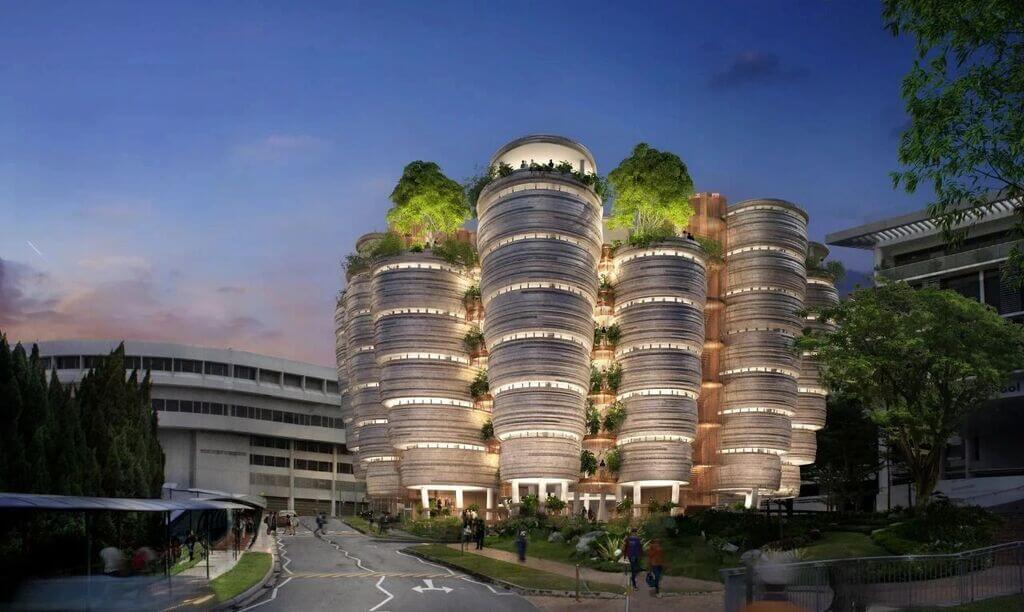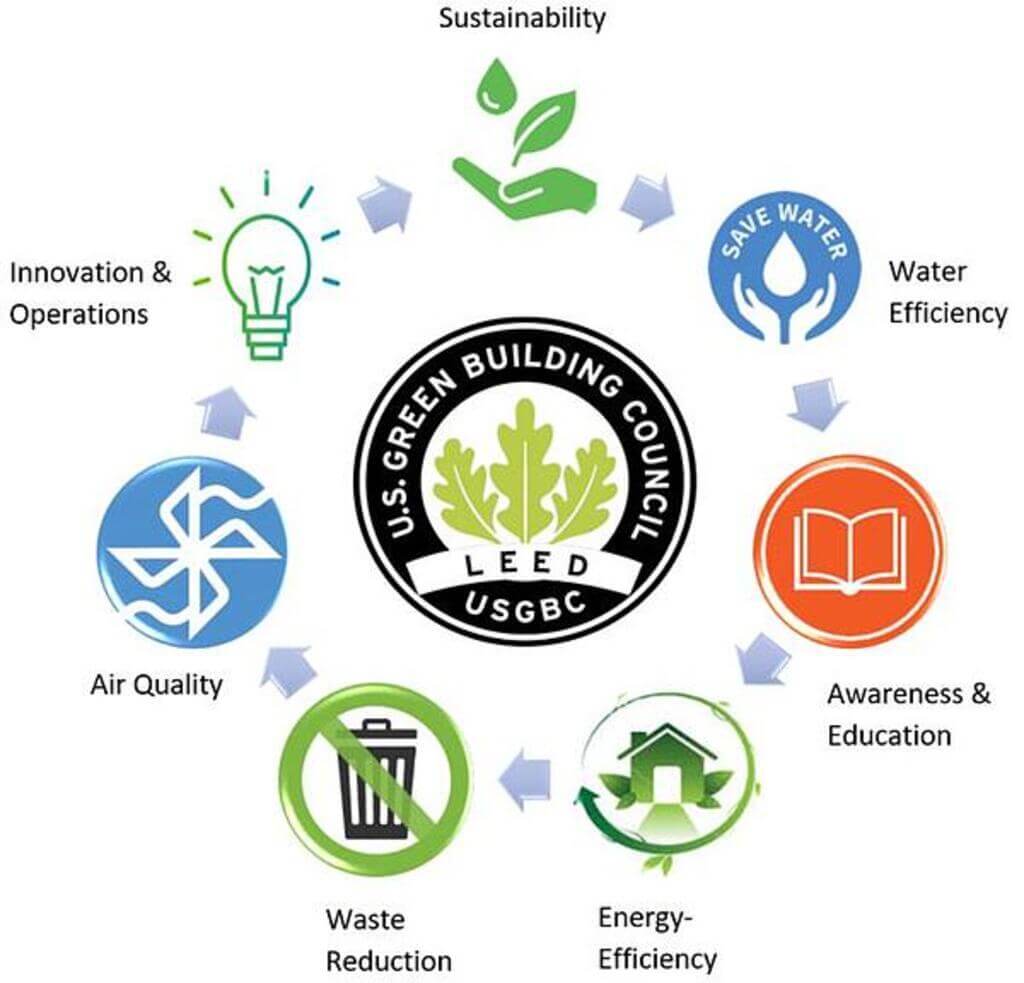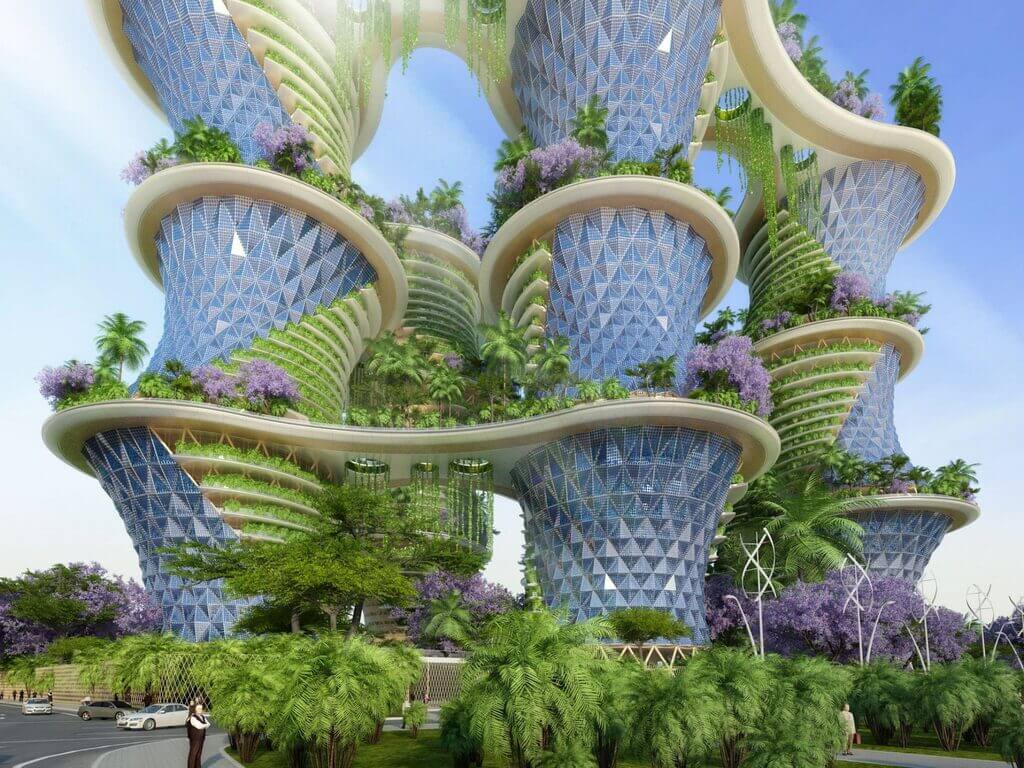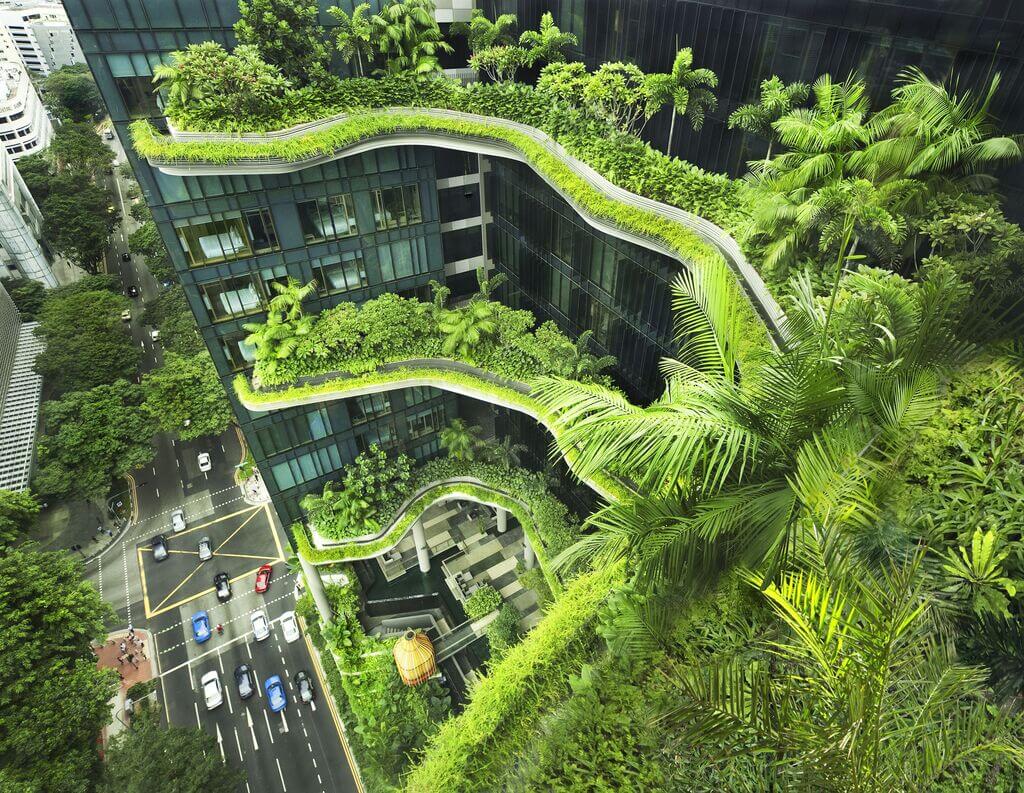“Our rules and regulations are about things that aren’t pertinent any more – stick frame houses that you pump heat into, endless amounts of energy and water – wasteful methods of living. Those days are overdue to climate change, population explosion, and dwindling resources. If you project them into the future we’ve got a problem.”, says the architect Michael Reynolds.
Sustainability is a thought-provoking term that has caught global attention in the 21st century. So what makes sustainability and green building architecture so vital in today’s time? An environmental crisis being on the verge has created a global cry for sustainability to step in.
From melting of the glaciers to greenhouse gases, the outcome from human negligence towards nature has now turned into its most horrific sights. Our dependency on finite resources has led to a climate issue that can lead to long-term environmental issues that can be irreversible and irreparable.
We need to identify alternate resources and efficient sustainable architecture concepts speedily. Our buildings give out up to 39 percent of greenhouse gases and pollutants from their construction and execution to its post-occupancy. Sustainable architecture needs to be rethought globally. Although this phenomenon of the sustainable architecture dates back to the 1960s and 70s, it has now been given its true diligence and attention.
A surge of global architects started a provocative thought of going back to nature by making use of it in a conscious way. A decade where glass, steel, and cement had taken over global domination in the construction industry. The thought of going back to nature was rather sidelined. Although now in the new age,
A global reach through technological advancements has eased out this process by helping society collaborate on a mass level turning sustainable architecture into an easily adaptable concept.
What is Sustainable Architecture?

An architectural technique that aims to minimize the negative environmental impact of buildings by the use of efficient building designs with the use of materials, energy, ecosystem, etc. Sustainable architecture paramount a conscious approach to energy and ecological conservation in the design of the built environment.
The main goal behind this thought is to ensure that our usage of presently available resources does not end up having harsh effects in the long run. Sustainable architecture also infuses the thought that our infinite resources should be used more than finite resources through innovation and technological ideations. The sustainable architecture concept is inclusive of energy efficiency, water and waste management, landscaping, re-adaptive usage, and several other phenomena.
Green Rating Organizations

A large number of Green Rating systems have been established to have a direct and indirect impact on the environmental crisis. These systems help to mitigate core issues through encouragement and recognition of sustainability performance. It identifies these buildings and gives them a platform to encourage more people to opt for sustainably built structures.
The BRE’s rating system, BREEAM was one the most primitive green rating systems in the UK around the 1900s which was followed by the US Leadership in Energy and Environmental Design (LEED) rating system in 2000. It is an individual third-party verification for new construction, existing buildings, commercial interred, core and shell, retail, healthcare, homes as well as entire neighborhood developments.
The performance of LEED-rated buildings is calculated based on water efficiency, energy and atmosphere, materials, indoor environment quality, location and connectivity, awareness, innovation, and other regional prerequisites. Now there are almost 300 green certification systems worldwide catering to the global cause of sustainable architecture.
These systems measure the levels of performance intending to create projects that are environmentally conscious and use resources efficiently throughout the lifecycle of a project. Energy Star is a USA-based rating system that focuses on energy efficiency and water use at its core. Green Globes is also an assistance and guidance program for existing and new buildings The credits for this program are based on energy use, indoor environment, site surroundings, water resources, emissions, and environmental management.
There are several benefits in going for sustainable architecture by using green rating systems
- It generates positive environmental aspirations
- Environmental performances can also be verified beforehand.
- Environmental building performance can be demonstrated to third parties.
- Green education can be imparted through practical demonstrations and applicability
- Positive marketing can be generated in the market to help in further sales.
Sustainable Architecture Concept – Then and Now!

Sustainability dates back to as old as the Roman era where a systematic way of city planning was established with mechanisms like water Aqueducts, sewage systems, etc. Gravity-driven structures became the core of city planning to ease out day-to-day activities while respecting the surroundings.
Even in Greek Architecture, the positioning of the buildings became one of the sustainable architecture concepts where the structures were oriented as per the sun’s direction. This in turn elevated the building quality making it more sustainable with little or no external dependencies.
Global architects like FL Wright, Renzo Piano, Glenn Murcutt, Norman Foster, Perkins + Will, etc started seeing sustainable architecture in green building design as a mandatory than an added luxury. Their inclusivity with this concept led to green architecture and buildings to look more aesthetic as well as ecological.
Another string of ecological architects emerged that believed in merging vernacular architecture with a modernist design thought, which gave rise to green architecture in the simplest form. Many nature-oriented locations like Bali, Vietnam, Sri Lanka, etc are seeing this form of sustainable architecture on a large scale.
Advantages of Sustainable Architecture
The advantages of sustainable architecture fall into three main categories, namely – environmental benefits, financial benefits, and social benefits.
Following are some of its advantages
- Increased Productivity – As reported by several researchers, environmentally friendly workspaces help the employees to perform better while working.
- Cost Reduction – With an efficient work method that is smart and functional, sustainable architecture concepts can help a design to be cost-efficient as well. Overall a green building costs less than a traditionally built structure. On top of that, green buildings have ROI that helps in increasing your property value up to a considerable margin.
- Health Benefits – Green building architecture has several health benefits as well as they are built around the site conditions without hampering its natural flora and fauna. This makes the air two to five times cleaner. Sustainable materials in building construction also help in purifying the air making it a win-win option to go for.
- Minimal Wastage – Green building architecture minimizes waste with its lower environmental impact and use of infinite resources. Waste management is a core criterion of a green building where sewage treatment plants, irrigation systems, dual flushing systems, etc are some of the mandates that ensure less wastage.
- Protecting the Environment – Using recycled material during construction, reusing, and re-adapting available materials on site are some of the features that are making sustainability, and environmental saver!
Installation of insulation windows, solar heaters, solar panels, insulated air conditioning pipes, ample amount of natural landscape, perforated tiling systems, etc are accounting to make sustainable architecture less harmful to the environment.
- Less Noise Pollution – Sustainable architecture puts extra attention on noise pollution that could be avoided in green construction. This is achieved through the planting of more trees to create a green buffer, noise barriers, etc are some of the methods that are used.
- Quality of life – Living in a green neighborhood elevates the quality of life by providing health benefits, noise protection, lively atmosphere, green pockets, etc making it an ideal option in an urban jungle.
- Marketing – Green building architecture has also proven to be a USP in attracting the user group towards a gated community as it ensures better liveability.
- Experimentation and innovation – Sustainable architecture create many opportunities for creative experimentation in the industry. The emergence of new materials with multiple uses as well as new architectural typologies are emerging due to it. A ski slope amid a new power plant in Copenhagen is one such example.
Thus, sustainable architecture has more than one benefit.
Disadvantages of Sustainable Architecture
Every phenomenon comes with a set of pros as well as cons, sustainable architecture also has its set of disadvantages. Although, the advantages of sustainable architecture easily outweigh its cons.
- Higher initial cost – The initial cost of sustain architecture techniques and buildings can be slightly higher than the conventionally used methods. Although, sustainable methods have zero or less maintenance and running cost which accounts for making it a money saver in the long run.
- Funding – Sustainable methods generally have a hard time getting funds from banks as many techniques are still considerably new.
- Availability – Green building materials are not easily available than conventional materials making the transportation and other costs slightly higher.
- Skilled Labour – Finding artisans, laborers, service providers, etc that have expertise in green building construction can cost slightly more than conventional service providers.
- Time Consuming – Due to their design specifics, green building architecture can be time-consuming to build.
- Not all green is ‘Green’ – One needs to be as researched as possible to ensure that the materials that are using are green. As a trend almost every service provider has claimed its share in being green. There is a need to research the products well before buying them. The basic rule to look for is to ensure that the materials are outsourced from sustainable resources through various certifications and NGOs that look after these criteria.
Where Is Green Building Architecture Headed in the Next 20 Years?
Since the 1960s, sustainable architecture has achieved great achievements and has helped it to move into mainstream vision. Many large multinational companies like Apple, Starbucks, Nike, Tesla, etc have hired third-party organizations to revamp their methods of functioning with a more robust sustainable option.
Microsoft intends to be completely sustainable by the year 2030. These MNCs have embraced sustainability as a whole which is, in turn, encouraging consumers, investors, and government bodies to think about this phenomenon in a deeper sense. A collaboration between NGOs and community organizations is now considered a primal way to encourage sustainable architecture and green methods in every domain of our lifestyle.
Before Corporate Social Responsibility (CSR) was considered as risk mitigation, now sustainable architecture has proven to make the companies more collaborative to CSR methods in encouraging sustainable architecture.

“We need to respond to what our customers are asking us to do, not just for electric vehicles and products, but for new services too. Some companies have a purpose that goes beyond just manufacturing a product.
“There is a load of signals, but customers are looking at people to deliver aspirations. We’re going to do our best to bring costs down, push excitement up among consumers and make sure we get a piece of the pie.”, says Francisco Carranza Sierra, managing director, Renault-Nissan Energy Services
The current progress of sustainable green architecture has given a sense of positive direction to the upcoming years where green architecture will be treated as a mandate rather than an added luxury element. Mass adaptability to this idea and several other environmental policies are creating a conscious global awareness. Right now, sustainable green architecture is mainly seen in Tier 1 cities but the future holds a strong inclination towards its adaptability in Tier 2 and 3 cities as well.

Technological advancement has also muttered to make sustainable architecture not just environmentally friendly but also pocket-friendly. With innovations like Solar Pergolas, Wind towers, Green Facades, etc. green building architecture is functional as well as aesthetic. A holistic approach towards sustainability thus, assures its workability in the coming years.
FAQs
Sustainable architecture is the usage of design principles and strategies that reduce or nullify the negative environmental impact during the construction as well as execution process of our buildings. Using conscious methods to make a design such as water efficiency, landscaping, energy efficiency, waste management, etc are some of the green methods.
Sustainable design principles include the following abilities
Optimizing the site potential
Using environmentally friendly products
Enhancing indoor environmental quality
Protecting and conserving water
Minimizing the usage of non-renewable materials
Sustainability has several benefits on an environmental, financial, and social level. It helps you in making a design environmentally friendly while keeping its cost cheaper. It also makes society more aware and conscious.
Environmentally friendly architecture is the construction of buildings that are efficient throughout the life cycle from construction to execution. It’s efficient up to a point that its occupants can also be benefited from it. They are more than just a passing trend, they are here to stay.
An efficient operating system, cost reduction, better liveability, etc are some of the advantages of opting for sustainable architecture.
For home decor, one can always opt for an energy-efficient light system like LED, CFL, etc. Installing a dual flushing system, reusing water for irrigation, etc can be one such method.
Find out more:-

